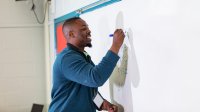Moving Beyond Status in Math Class
By focusing on ideas rather than individual students, math teachers can move beyond assumptions that some kids are ‘good’ at math.
When math teachers talk with one another about their classes, it might sound like this: “When I make groups, I put a high student with a low student” or “Bella always tries to contribute, but she gets off track.”
Students often echo similar sentiments: “Why would we look at Ellie’s math work?” and “I need to help Juan because he doesn’t get math.”
As these examples illustrate, issues of status defined by our biases about what individual students have to offer often surface in mathematics class. Rather than focusing on the math idea presented, the emphasis is placed on who said the idea. This creates inequity and status as both students and teachers sort students into groups of high, medium, and low.
Status in Math Classrooms
Building and creating an equitable math classroom is critical for strong mathematics learning to happen. Status issues impact students on the margin and harm the learning environment for everyone. Status issues also disadvantage students who have been put in “gifted” programs; as Jo Boaler notes in the film Rethinking Giftedness, “The labeling of some students sends negative messages about potential that are out of sync with important knowledge of neuroplasticity.”
Teachers play a big part in students’ perception of status. Although it can appear to be outside our control, status isn’t fixed. The teacher’s beliefs about students’ capabilities influence who students perceive to have high and low status in the classroom. As teachers, our role is to disrupt status so that all students are seen as intellectual contributors to the math learning in the classroom.
3 Ways to Disrupt Status
1. See math broadly. When we overvalue fast computational skills, we leave out the diversity of approaches and skill sets that the discipline needs and requires. If your focus is on answer-getting rather than thinking, students will develop a shallow and limited idea of what counts as math.
Instead, we can prioritize thinking to develop a rich understanding of the mathematical terrain. While looking at student work with your colleagues, pose questions like these:
- What are the nascent ideas to work from?
- What are some questions we’d like to ask the students?
- Which students haven’t shared their ideas in public?
- How does this work help me see students’ multifaceted understandings of the material?
2. Create learning commitments with many ways to be mathematically smart. It’s important to create learning environments that encourage multiple abilities, develop mathematical mindsets, and center learning on students. One of the first things you can do at the beginning of the year is create, along with students, a set of learning commitments that will guide your community work. Learning commitments communicate the importance of everyone’s voice and what, as a group, you value—what Janelle W. Henderson describes as cultivating a high-trust climate. Learning commitments need to be seen as a touchstone, something you and your students will use and reflect on throughout the year by embedding it into your daily practice.
Many teachers create math groups with “high” and “low” achieving students. This instructional strategy sends an implicit message that learning is one-sided. If a student’s math thinking is continually ignored or dismissed, the student will stop engaging and begin to perceive themselves as “not a math person.” The more students talk about their math thinking and ideas, the more students will learn. So, if students are not talking because of how they believe their ideas may be perceived, they are not learning.
Instead of grouping students by “high” and “low,” consider framing partnerships with learning commitments that promote equal-status interactions. You can say, “Today, while you are working with your partner, I am going to look for partnerships that push each other’s thinking by asking questions. When we come back together, we will share out different ways that partnerships pushed each other’s thinking.”
3. Listen to student ideas and questions. Teachers should believe that students have ideas worth listening to, that they have something to say, and that it will enlighten you and the class. This means positioning yourself as someone who has a lot to learn about both the content and your students.
Consider this vignette: A fourth-grade classroom is learning the US standard algorithm for subtraction. The problem is: 432–58. The teacher presents the steps: “I can’t take 8 from 2, so I need to borrow one from the 3. Cross out the 3, and it is now a 2. I will give the 1 to the 2 to make it a 12. Now I can subtract the 8 from 12.”
Bella then asks, “Wait, what? How did the 1 turn into a 10?” Instead of proceeding, the teacher can stop and respond, “What an interesting question, Bella—what do others think? Turn and talk to your neighbor to see if we can understand how the 1 turned into a 10.” We often feel as though we have to “get through the lesson” because teachers have pacing guides to follow and real constraints on their time. Strong planning protocols anticipate students’ math thinking and questions and help teachers elevate student contributions to support the learning of the whole class. Elevating Bella’s question makes the thinking and reasoning public for all students to grapple with and make sense of. Her question, in particular, is at the heart of making meaning of the notation of the standard algorithm and why it works.
Decisions that teachers make are important. Grounding them in student thinking and reasoning is essential. When we position ourselves to see and hear the brilliance of each and every student, we will.
